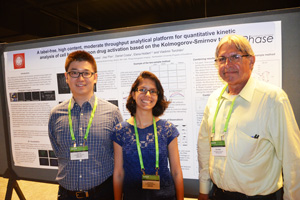Big Data, Fewer Cells

To test if a cancer drug has an effect, drug treated cells are compared with untreated cells. Traditionally this is done by comparing population histograms, using a statistical method known as the Kolmogorov-Smirnov test. Population histograms are created at a specific point in time. But, as HoloMonitor® can monitor cells minute by minute over days it can also create very detailed time series plots of each cell, similar to stock market graphs.
Big data analysis
At the recent scientific conference on Engineering and Physical Sciences in Oncology organized by the American Association for Cancer Research (AACR), scientists from Northeastern University presented a big data analysis method based on a modified Kolmogorov-Smirnov test.
The scientists have used the newly developed method to compare time series data of drug treated cells with untreated cells. The work was spearheaded by Ed Luther who manages the Holographic Imaging Cytometry Program of Excellence at Northeastern University.

“By non-invasively observing cells over time, HoloMonitor can quantify the effect of a drug using only a few cells – which is important in developing personalized cancer treatment strategies”
— Northeastern scientist Jiayi Pan, Livia Mendes and Ed Luther
AACR conference in Boston
Fewer cells
To reliably prove the effect of a drug using conventional population histograms a large number of cells, which are often quite precious, are needed. When time series data is used instead, fewer cells are required to validate the effect. The statistical robustness lies in the number of time points, not in the number of cells.
Personalize cancer treatment
Flow cytometry is still the mainstream cell analysis method. One of the key strengths of flow cytometry is its ability to acquire data for population histograms from a large number of cells.
Flow cytometry is however invasive, making it impossible to acquire data from the same cell over time. By non-invasively observing cells over time, the Northeastern scientists show that HoloMonitor can quantify the effect of a drug using only a few cells – which is important in developing personalized cancer treatment strategies.
Northeastern publicaitons
Since the Holographic Imaging Cytometry Program of Excellence was established at Northeastern University in late 2014, the progress has been remarkable:
- 2 peer reviewed articles in high profile journals,
- 2 articles currently in press and
- over 5 presentations at scientific meetings.
These publications can be found here, together with publications by other HoloMonitor users.


